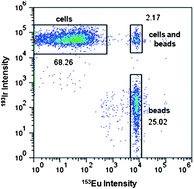Abstract
We examine the suitability of metal-containing polystyrene beads for the calibration of a mass cytometer instrument, a single particle analyser based on an inductively coupled plasma

- This article is part of the themed collections: 2010 Young Analytical Scientists and Analytical Atomic Spectrometry in Biomedical Sciences

 Please wait while we load your content...
Please wait while we load your content...